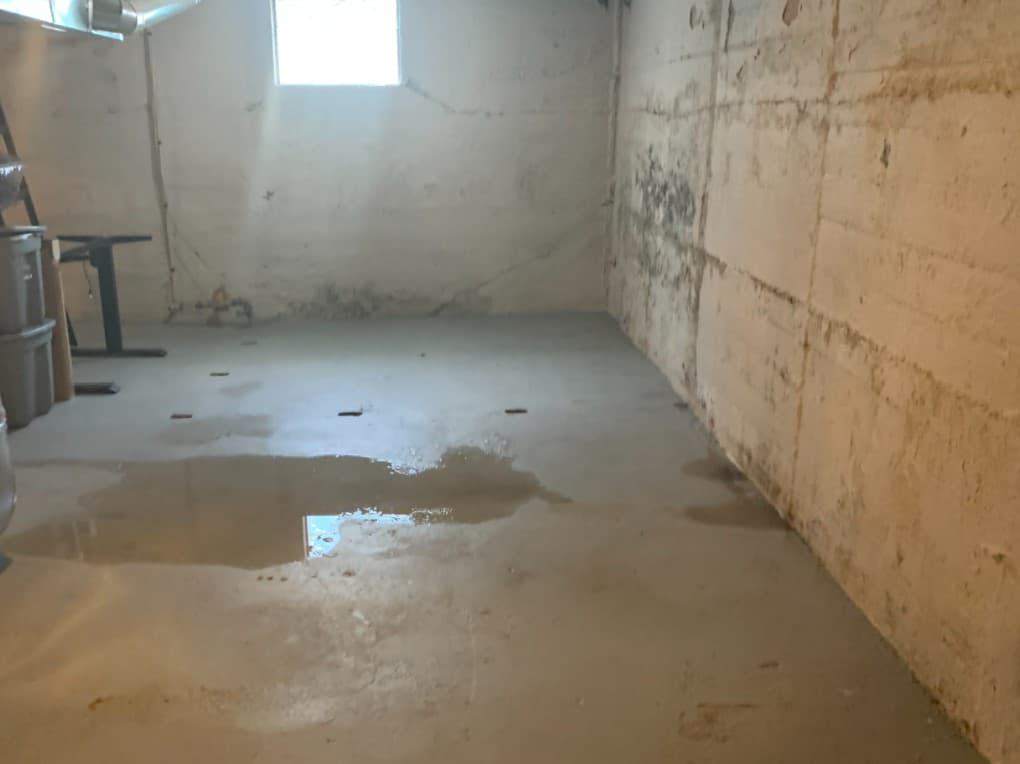How To Fix A Hydrostatic Pressure Issue Leading To Wet Basement?
Hydrostatic pressure occurs due to the pressure exerted on the building walls by the standing soil or groundwater around the foundation.
Author:Suleman ShahReviewer:Han JuJan 03, 202535.7K Shares510.1K Views

Most New York homeowners report that the common culprit behind wet basements is hydrostatic pressure, which eventually leads to structural damage. Hydrostatic pressure occurs due to the pressure exerted on the building walls by the standing soil or groundwater around the foundation. Thus, it is necessary to understand why hydrostatic pressure occurs and what the signs are to detect it so that you can apply measures to keep a healthy basement environment.
What Is Hydrostatic Pressure?
The force exerted by the groundwater around the house's foundation is called hydrostatic pressure. It occurs when the soils surrounding the foundation become saturated, creating pressure that pushes the water against the cracks or joints in the basement.
The common reasons behind this can be heavy rainfall, faulty drainage systems, or even a high water table. If you are interested in for hydrostatic pressure coverage, you should speak with the experts in detail.
How Does Hydrostatic Pressure Lead To A Wet Basement?
After the water starts accumulating around the foundation, there is an increased hydrostatic pressure that forces moisture into the building through the cracks and openings on the floor and wall. This damage occurs for a long time, after which you can see a visible sign of water seepage, dampness, or even the growth of mold in your basement.
Signs Of Hydrostatic Pressure Issues
The most probable signs to identify hydrostatic pressure are vertical, horizontal, or stair-step cracks on the floors and walls due to water-induced pressure. You can also find moisture on the wall, floor, or even water stains.
Moreover, even if you dry the area or the water gets evaporated, a white powdery residue remains on the wall, which is the mineral deposit, indicating a hydrostatic pressure issue. Lastly, if the signs are not addressed for the long term, it can lead to persistent dampness and growth of fungi and mold in the basement.
Preventing Hydrostatic Pressure-Related Basement Issues
Here's what you need to do:
Improve Exterior Drainage
The first step to fixing hydrostatic pressure-related issues is to regularly clean the gutter so that it does not get clogged and water flow is maintained. You must also ensure that the downspout discharges the water 11 feet from the foundation. Moreover, always create a landscape around your house so that the slope directs the water away from it to reduce soil saturation.
Install A Drain Tile System
You can also install a drain tile system, which will collect water that enters the basement and, with the help of a sump pump, expel it away from the house. Moreover, the exterior drain tile system would act as a perimeter and prevent water from entering the basement.
Apply Waterproofing
You can also create a barrier against moisture from penetrating the basement by using waterproof sealants in the house's interior walls. You can also remove the accumulated water from the basement by installing a sump pump. Most importantly, you must seek professional help to seal the cracks in the foundation walls and floor, preventing water ingress.
Conclusion
If you notice that even after applying the above methods, there are still visible signs of persistent moisture, then you need to consult with a foundation repair specialist through zicklincontracting.com. They can help you sort out the structural concerns and hydrostatic pressure issues to safeguard your home.

Suleman Shah
Author
Suleman Shah is a researcher and freelance writer. As a researcher, he has worked with MNS University of Agriculture, Multan (Pakistan) and Texas A & M University (USA). He regularly writes science articles and blogs for science news website immersse.com and open access publishers OA Publishing London and Scientific Times. He loves to keep himself updated on scientific developments and convert these developments into everyday language to update the readers about the developments in the scientific era. His primary research focus is Plant sciences, and he contributed to this field by publishing his research in scientific journals and presenting his work at many Conferences.
Shah graduated from the University of Agriculture Faisalabad (Pakistan) and started his professional carrier with Jaffer Agro Services and later with the Agriculture Department of the Government of Pakistan. His research interest compelled and attracted him to proceed with his carrier in Plant sciences research. So, he started his Ph.D. in Soil Science at MNS University of Agriculture Multan (Pakistan). Later, he started working as a visiting scholar with Texas A&M University (USA).
Shah’s experience with big Open Excess publishers like Springers, Frontiers, MDPI, etc., testified to his belief in Open Access as a barrier-removing mechanism between researchers and the readers of their research. Shah believes that Open Access is revolutionizing the publication process and benefitting research in all fields.

Han Ju
Reviewer
Hello! I'm Han Ju, the heart behind World Wide Journals. My life is a unique tapestry woven from the threads of news, spirituality, and science, enriched by melodies from my guitar. Raised amidst tales of the ancient and the arcane, I developed a keen eye for the stories that truly matter. Through my work, I seek to bridge the seen with the unseen, marrying the rigor of science with the depth of spirituality.
Each article at World Wide Journals is a piece of this ongoing quest, blending analysis with personal reflection. Whether exploring quantum frontiers or strumming chords under the stars, my aim is to inspire and provoke thought, inviting you into a world where every discovery is a note in the grand symphony of existence.
Welcome aboard this journey of insight and exploration, where curiosity leads and music guides.
Latest Articles
Popular Articles